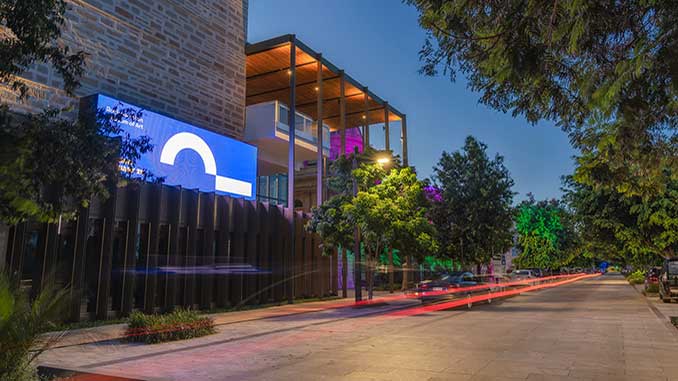 The reimagined Rockhampton Museum of Art (RMOA) is set to become a vibrant new community hallmark, representing an ongoing commitment to honouring history, celebrating inclusivity, and reinforcing Queensland’s position as the home of Australian contemporary art.
The reimagined Rockhampton Museum of Art (RMOA) is set to become a vibrant new community hallmark, representing an ongoing commitment to honouring history, celebrating inclusivity, and reinforcing Queensland’s position as the home of Australian contemporary art.
Officially opening its doors today (Friday 25 February), RMOA’s redevelopment is an Australian-first for the arts sector, seeing the gallery’s existing site overlooking the Fitzroy River (‘Tunuba’) expanded into a vast precinct with permanent and touring galleries, education spaces, community recreation areas and a restaurant and cafe.
Inspired by RMOA’s core pillars of creativity and connection, architects Claire Design collaborated with Conrad Gargett Architects and Brian Hooper Architects to realise a dynamic and authentic community space. Integrating seamlessly into its surrounding environment and complementing the iconic Customs House nearby, the building and surrounding precinct will inspire locals and tourists to interact with visual art as part of a broader social and cultural experience.
Jointly funded by the Australian Government, Queensland Government, and the Rockhampton Regional Council, RMOA’s redevelopment will make the gallery’s acclaimed holding of Australian modern art more accessible than ever. Vast exhibition spaces will invite visitors to discover a collection acquired over five decades under the vision of former long-serving Rockhampton Mayor and project inspiration Rex Pilbeam.
“The reimagined RMOA is first and foremost a meeting place. It will be a site that fosters a fundamental sense of place and community through a celebration of visual art, engaging locals and tourists in the evolving narrative of the Rockhampton and its diverse cultural heart,” says Rockhampton Regional Council Mayor Tony Williams.
“We are thrilled to see the precinct come to life as a new community hallmark, its architecture and integration with the broader environment reflects a progressive vision, while celebrating the region’s rich history.”
The vision for RMOA has also been enriched by an extensive First Nations engagement program designed to educate visitors and the local community about the significance of the site’s location and histories on Darumbal Country.
Further emphasising First Nations culture and creativity, RMOA has commissioned a major work by Bidjara, Ghungalu and Garingbal artist D. Harding for the launch, his piece reflecting cultural and site-specific narratives intrinsic to Country, and a universal celebration of the creative spirit.
Titled Wall Composition on Darumbal – the work draws on the Museum’s location and proximity to significant geographic markers, seeking to continue conversations about Indigenous Australian culture and heritage across the local Rockhampton community and beyond.
Conjuring a narrative of the nearby Tunuba (Fitzroy River), the wall painting’s striking ultramarine blue hues denote the site as one of the main geographic markers in Rockhampton; a source of deep cultural significance and creative inspiration for Central Queensland’s Indigenous communities.
“The Tunuba is the foundation of the work, both visually and thematically. It has been central to my conversations with the local elderhood in Central Queensland and also the team here at Rockhampton Museum of Art when discussing what themes might be relevant to explore in this work,” D says.
“A range of different figures have been built upon the river base including figures of tree forms, local botanical figures and other references to Rockhampton on Darumbal land. These elements express shared histories from Rockhampton families and the wider community,” they say.
Joining GOMA and HOTA as another world-class arts hub in Queensland, RMOA will boost tourism, local morale, and economic activity in the region. The museum places Rockhampton on the world stage, with a curatorial program and state-of-theart facilities worthy of its acclaimed collection. The gallery will also attract new headline exhibitions and international artists whose work may have only been exhibited in capital cities.
“Our approach to running the gallery and its scheduled programming will champion inclusivity. We are excited to bring big artists and exhibitions to Rockhampton, but we are equally excited about making these creative spectacles accessible for the entire community, even people who might not consider themselves art afficionados,” says RMOA Director Jonathan McBurnie.
“Success for us at RMOA will see visitors from all ages and demographics make meaningful social connections with each other through a shared celebration of art, creative energy and diversity. It is a place where all are welcome,” he says.
With a major focus on education and strengthening cultural connections, RMOA includes range of mixed-use spaces to host school, university, and community groups, in which curators, guests and gallery staff will activate community-focussed programs and esteemed art awards throughout the year, including the prestigious biennial Gold Award.
The Rockhampton Museum of Art (RMOA) opens today (Friday 25 February). For more information and exhibition program, visit: www.rmoa.com.au for details.
Image: Rockhampton Museum of Art (supplied)
